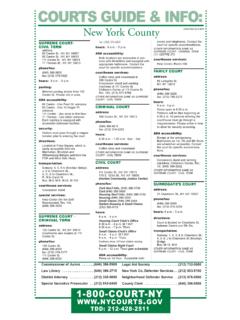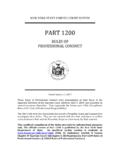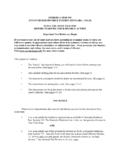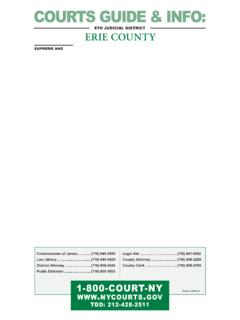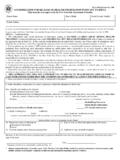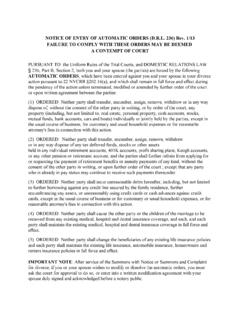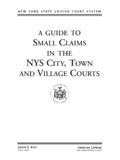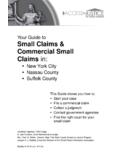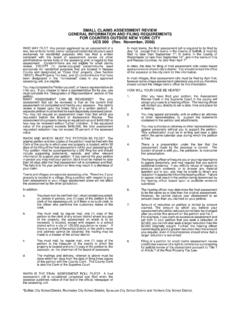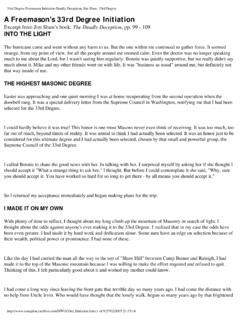Transcription of JUSTIFICATION: USE OF DEADLY PHYSICAL FORCE IN …
1 JUSTIFICATION: USE OF DEADLY PHYSICAL FORCE IN DEFENSE OF A PERSONPENAL LAW (2)(Effective Sept. 1, 1980)(Revised Jan. 2013; Feb. & July 2016; Jan. 2018)1 _____NOTE: This charge should precede the reading of theelements of the charged crime, and then, the final elementof the crime charged should read as follows: and, #. That the defendant was not justified. 2_____[With respect to count(s) (specify),] [T]he defendant hasraised the defense of justification, also known as self defense. The defendant, however, is not required to prove that he wasjustified. The People are required to prove beyond a reasonabledoubt that the defendant was not will now explain our law's definition of the defense ofjustification as it applies to this case. Under our law, a person may use DEADLY PHYSICAL forceupon another individual when, and to the extent that, he/shereasonably believes it to be necessary to defend himself/herself[or someone else] from what he/she reasonably believes to be theuse or imminent use of [unlawful3] DEADLY PHYSICAL FORCE by suchindividual.
2 Some of the terms used in this definition have their ownspecial meaning in our law. I will now give you the meaning of thefollowing terms: " DEADLY PHYSICAL FORCE " and "reasonablybelieves." DEADLY PHYSICAL FORCE means PHYSICAL FORCE which, under the circumstances in which it is used, is readily capable ofcausing death or other serious PHYSICAL [Serious physicalinjury means impairment of a person's PHYSICAL condition whichcreates a substantial risk of death, or which causes death orserious and protracted disfigurement, protracted impairment ofhealth or protracted loss or impairment of the function of anybodily ]The determination of whether a person REASONABLYBELIEVES DEADLY PHYSICAL FORCE to be necessary to defendhimself/herself [or someone else] from what he/she reasonablybelieves to be the use or imminent use of DEADLY PHYSICAL FORCE byanother individual requires the application of a two-part That test applies to this case in the following way.
3 First, the defendant must have actually believed that(specify) was using or was about to use DEADLY physicalforce against him/her [or someone else], and that thedefendant's own use of DEADLY PHYSICAL FORCE wasnecessary to defend himself/herself [or someone else] fromit; andSecond, a "reasonable person" in the defendant'sposition, knowing what the defendant knew and being in thesame circumstances, would have had those same , under our law of justification, it is not sufficient thatthe defendant honestly believed in his own mind that he wasfaced with defending himself/herself [or someone else] againstthe use or imminent use of DEADLY PHYSICAL FORCE . An honestbelief, no matter how genuine or sincere, may yet beunreasonable. To have been justified in the use of DEADLY PHYSICAL FORCE , the defendant must have honestly believed that it was necessaryto defend himself/herself [or someone else] from what he/shehonestly believed to be the use or imminent use of such FORCE by (specify), and a "reasonable person" in the defendant's position,knowing what the defendant knew and being in the samecircumstances, would have believed that too.
4 On the question of whether the defendant did reasonablybelieve that DEADLY PHYSICAL FORCE was necessary to defendhimself/herself [or someone else] from what he/she reasonably2believed to be the use or imminent use of such FORCE by (specify), it does not matter that the defendant was or may have beenmistaken in his/her belief; provided that such belief was bothhonestly held and reasonable.[Add if there was evidence of a party s reputation forviolence:Now, you have heard testimony that (specify) had areputation for violence and engaged in violent acts. Normally, the law does not permit such testimony. Thereason is that every person, regardless of that person'srelative worth to the community, has the right to liveundisturbed by an unlawful assault. However, in assessing whether the defendant did"reasonably believe" that the DEADLY PHYSICAL FORCE he/sheused was necessary to defend himself/herself [or someoneelse] from what he/she "reasonably believed" to be the useor imminent use of such FORCE by (specify), you mayconsider whether the defendant knew that (specify) had areputation for violence or had engaged in violent acts.]
5 If so,you may then consider to what extent, if any, thatknowledge contributed to a "reasonable belief" that thedeadly PHYSICAL FORCE the defendant used was necessary todefend himself/herself [or someone else] from what he/she"reasonably believed" was the use or imminent use of suchforce by (specify).7 Further, provided the defendant believed (specify)had such reputation or engaged in such acts, it does notmatter whether that belief was correct.]3[Add as applicable:Notwithstanding the rules I have just explained, thedefendant would not be justified in using DEADLY PHYSICAL forceunder the following circumstances:Select appropriate alternative(s):(1) The defendant would not be justified if he/she was theinitial aggressor of DEADLY PHYSICAL FORCE ;[Add if applicable: except, that the defendant's use of DEADLY PHYSICAL forcewould nevertheless be justified if he/she had withdrawnfrom the encounter and effectively communicated suchwithdrawal to (specify) but (specify) persisted in continuingthe incident by the use or threatened imminent use of (unlawful8) DEADLY PHYSICAL FORCE .]
6 ][Arguing, using abusive language, calling a person names,or the like, unaccompanied by PHYSICAL threats or acts, does notmake a person an initial aggressor and does not justify physicalforce.]"Initial aggressor" means the first person who uses, orthreatens the imminent use of, DEADLY PHYSICAL FORCE . The actual striking of the first blow or inflicting of the firstwound, however, does not necessarily determine who was theinitial aggressor. A person who reasonably believes that another is about touse DEADLY PHYSICAL FORCE upon him/her need not wait until he/sheis struck or wounded. He/she may, in such circumstances, be thefirst to use DEADLY PHYSICAL FORCE , so long as he/she reasonablybelieved it was about to be used against him/her. He/she is thennot considered to be the "initial aggressor," even though he/shestrikes the first blow or inflicts the first [Add if there was evidence of DEADLY FORCE responding to non- DEADLY FORCE :If a person initially uses or threatens the use of non-deadlyphysical FORCE against another who, in response, uses orthreatens the imminent use of DEADLY PHYSICAL FORCE , then thatperson who first used or threatened the imminent use of deadlyphysical FORCE is the initial ][Add if there was evidence that the defendant was an intervenor.
7 If a person intervenes in a conflict in defense of another,that person is an initial aggressor only if he/she somehow initiatedor participated in the initiation of the original use of [ DEADLY ] PHYSICAL FORCE or the threat to use it, or reasonably should haveknown that the person he/she was defending initiated it. On theother hand, if he/she neither initiated, nor participated in theinitiation of [ DEADLY ] PHYSICAL FORCE , or the threat to use it, and hadno reason to know who initiated it, then he/she is not the ][Add if there was evidence of a reputation for violence:A person cannot be considered the initial aggressor simplybecause he/she has a reputation for violence or has previouslyengaged in violent ][Add if there was evidence of threats:You may (however) consider whether the deceased madethreats against the defendant prior to the time in question andwhether such threats indicated an intent to act upon them as theinitial aggressor.
8 In making that assessment, it does not matterwhether the defendant was aware of the ] 5(2) The defendant would not be justified if he/she knew thathe/she could with complete safety to himself/herself and othersavoid the necessity of using DEADLY PHYSICAL FORCE by retreating. [The defendant, however, would not be required toretreat if the defendant was in his/her dwelling and was notthe initial term, dwelling, encompasses a house, an apartmentor a part of a structure where the defendant lives and whereothers are ordinarily excluded. (The determination ofwhether a particular location is part of a defendant'sdwelling depends on the extent to which the defendant [andpersons actually sharing living quarters with the defendant]exercise(s) exclusive possession and control over the areain question.)14](3) The defendant would not be justified if (specify's) conduct was provoked by the defendant himself/herself withintent to cause PHYSICAL injury to (specify).
9 (4) The defendant would not be justified if the deadlyphysical FORCE involved was the product of a combat by agreementnot specifically authorized by law.]The People are required to prove beyond areasonable doubt that the defendant was not justified. NOTE: At this point, the trial court must select theappropriate alternative set forth below to fulfill the mandateof appellate decisions. See endnote ( 15 ). Those decisionsrequire that in a case with multiple counts, in which some orall of the counts include the same definition of justification asan element, the trial court s instructions (as well as its verdictsheet) need to convey to the jury that once the jury hasdetermined that the People have failed to prove that thedefendant was not justified as to a count, the jury must notreconsider that same justification defense as to any othercount and they must find the defendant not guilty of eachand every count for which that same definition of justificationis an element.
10 (For a sample verdict sheet, see CJI2d ModelVerdict Sheet for Justification.)61. In January 2013, the definition of initial aggressor was revised to includelanguage to better accommodate the dictates of People v McWilliams, 48AD3d 1266, 1267 (4th Dept 2008) ("We agree with defendant that, whereSelect appropriate alternative:(1) If justification applies to only one count, add the following:It is thus an element of count [specify numberand name of offense] that the defendant wasnot justified. As a result, if you find that thePeople have failed to prove beyond areasonable doubt that the defendant was notjustified, then you must find the defendant notguilty of that count. (2) If justification applies to more than one count submittedto the jury on the verdict sheet, add the following: It is thus an element of counts [specify numbers andnames of the offenses on verdict sheet] that thedefendant was not justified.)
